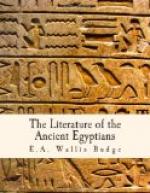[Illustration: Thoth and Amen-Ra Succouring Isis in the Papyrus Swamps.]
The scribe mixed on his palette the paints which he used. This palette usually consisted of a piece of alabaster, wood, ivory, or slate, from 8 to 16 inches in length and from 2 to 3-1/2 inches in width; all four corners were square. At one end of the palette a number of oval or circular hollows were sunk to hold ink or paint. Down the middle was cut a groove, square at one end and sloping at the other, in which the writing reeds were placed. These were kept in position by a piece of wood glued across the middle of the palette, or by a sliding cover, which also served to protect the reeds from injury. On the sides of this groove are often found inscriptions that give the name of the owner of the palette, and that contain prayers to the gods for funerary offerings, or invocations to Thoth, the inventor of the art of writing. The black ink used by the scribes was made of lamp-black or of finely-powdered charcoal mixed with water, to which a very small quantity of gum was probably added. Red and yellow paint were made from mineral earths or ochres, blue paint was made from lapis-lazuli powder, green paint from sulphate of copper, and white paint from lime-white. Sometimes the ink was placed in small wide-mouthed pots made of Egyptian porcelain or alabaster. The scribe rubbed down his colours on a stone slab with a small stone muller. The writing reed, which served as a pen, was from 8 to 10 inches long, and from one-sixteenth to one-eighth of an inch in diameter; the end used in writing was bruised and not cut. In late times a very much thicker reed was used, and then the end was cut like a quill or steel pen. Writing reeds of this kind were carried in boxes of wood and metal specially made for the purpose. Many specimens of all kinds of Egyptian writing materials are to be seen in the Egyptian Rooms of the British Museum.
[Footnote 1: In some parts of Mesopotamia where scribes at the present day use rough paper made in Russia, each sheet before being written upon is laid upon a board and polished by means of a glass bottle.]
[Illustration: Wooden Palette of Rameri, an official of Thothmes IV. 1470 B.C. Wooden Palette of Aahmes I, King of Egypt 1600 B.C.]




